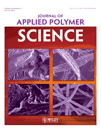Synergistic flame retardant effect of poly(ether sulfones) and polysiloxane on polycarbonate
Abstract
Flame retardance of bisphenol A polycarbonate (PC) was improved by the co-addition of poly (ether sulfones) (PES) and polysiloxane/acrylate copolymer (PSiA) while retaining a high rigidity and toughness. A UL 94 V-0 rating for 1.6-mm thick samples of PC/PES/PSiA blend with 10.0 wt % PES and 0.5 wt % PSiA (PC/10PES/0.5PSiA) was obtained. Its average heat release rate (av-HRR) in a cone calorimeter measurement was decreased by 19% on the basis of PC/PES blend with 10.0 wt % PES. Scanning electron microscopy (SEM) morphologies of impact-fractured surfaces revealed that the incorporation of 0.5 wt % PSiA decreased the dimensions of PES dispersed phase and provoked the uniform distribution of PES in PC matrix. Thermogravimetric-Fourier transform infrared spectroscopy analysis results revealed that PSiA dominantly promoted the degradation of PC and the degraded products were combined with PES to form a superior flame-retarded carbon layer. A higher sulfur and silicon content on the residue surface after vertical burning tests detected by SEM/energy dispersive spectrometer signified their accumulation during combustion. © 2011 Wiley Periodicals, Inc. J Appl Polym Sci, 2011




